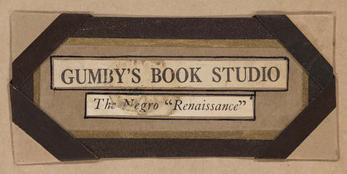About the Exhibit
More than 150 scrapbooks comprise the core of the Alexander Gumby Collection of Negroiana, part of the Rare Book & Manuscript Library at Columbia University. Together, these volumes contain a diverse array of manuscripts, photographs, pamphlets, artwork, clippings, and ephemera primarily related to African-American history from the nineteenth to the mid-twentieth centuries. At the time of its creation from about 1900 to 1950, the collection's curator, L.S. Alexander Gumby, explained that this "History of the Negro in Scrapbook . . . could well be called 'The Unwritten History'" of the United States, due to the lack of general scholarly attention paid to African Americans by contemporary historians.
This exhibition introduces visitors to the remarkable Gumby and situates his life and project in the context of the Harlem Renaissance--his acquaintances included luminaries such as Richard Bruce Nugent, Countee Cullen, and Langston Hughes--and in relation to other contemporary pioneers of African-American history such as Arthur Schomburg and Carter G. Woodson. Showcasing pages from nearly fifty of Gumby's scrapbooks, it highlights both the rare and the seemingly mundane items that Gumby argued could combine to document an otherwise forgotten history of the United States and its African American contributors.
Exhibit Structure
"The Unwritten History" seeks to provide insight into both the intellectual nature and context of Gumby's project as well as its content and execution. It is therefore structured in a manner that emphasizes the curatorial authority that Alexander Gumby exercised in both his selection of subject matter and his use of the scrapbook form. Beginning with an introductory section ("The Great God Gumby") that provides background information about Gumby and the origin of his scrapbook project, the exhibit proceeds to Gumby's Peers, a section which describes contemporary efforts similar to Gumby's and that in part inspired his own.
Following are five sections that provide a broad overview of the types of items that Gumby spent his life collecting. Gumby's Past presents his interest in identifying and preserving items--particularly those related to the African diaspora--from or about a history that he worried might otherwise be lost. Though contemporary to Gumby's own life, the items in Gumby's People and Gumby's Institutions similarly represent the types of noteworthy individuals and organizations of the first half of the twentieth century whose careers Gumby avidly followed and which he felt needed to be documented so that future generations would be able to write their histories. In contrast to these people-focused sections, Gumby's Events includes pages related to specific occurrences that Gumby felt deserved documentation, while the pages in Gumby's Culture showcase his attempt to capture in a condensed form some long-developing themes of popular discourse.
A Note on the Images
Each image that appears in this exhibit is a reproduction of a full page from one of Alexander Gumby's scrapbooks. Wherever possible, each image appears with a caption that lists the page number and title of the scrapbook from which it has been reproduced. Larger views and additional bibliographic information can be accessed by clicking on most images in the exhibit.
Exhibit Curator
Nicholas Osborne
Department of History
Columbia University
